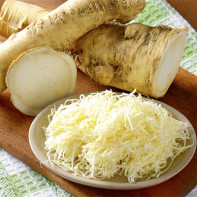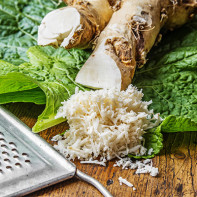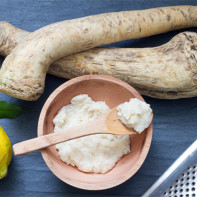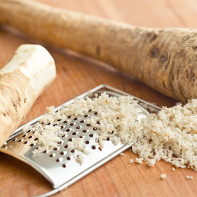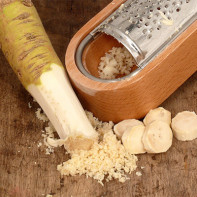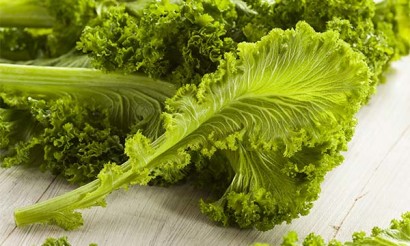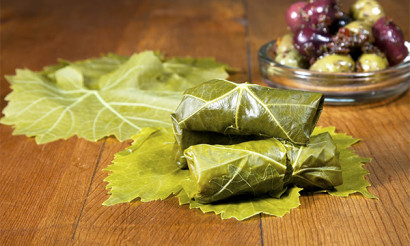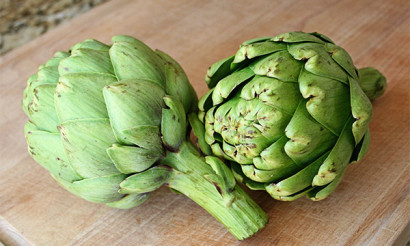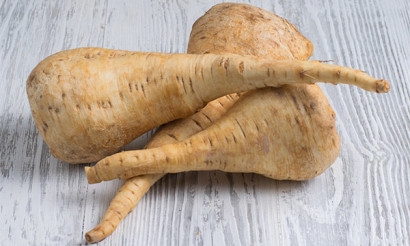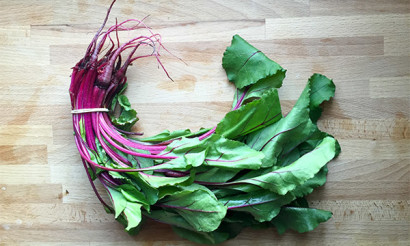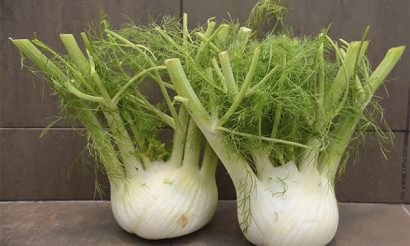Horseradish: useful properties and contraindications.
Horseradish is a vegetable crop, it grows everywhere except in the Arctic regions. While it was first added to food by the Greeks and Romans, it is considered an exclusively Russian seasoning. It was the Slavs who created many recipes based on it and discovered its many useful properties.
- Composition and calories
- Useful properties of horseradish
- For Women
- For Men
- When pregnant
- For breastfeeding
- For children
- Slimming
- The Use and Usage of Horseradish Leaves
- Horseradish in medicine
- For diabetes
- In pancreatitis
- For gastritis
- For gout
- For the liver
- For hemorrhoids
- Horseradish-based folk medicine recipes
- For diabetes
- For Joint Disease
- Osteochondrosis
- Colds treatment with horseradish
- Inhalation for cough
- Horseradish in cosmetology
- For Face
- For Hair
- Hazards and contraindications
- How to Choose and Store Horseradish
- Can I Freeze Horseradish?
- How to cook horseradish: Recipes
- Spice
- Recipe for "horseradish"
- How much horseradish can be eaten per day
- Interesting facts about horseradish
Cultivation of horseradish on the territory of modern Russia began in the IX century. And at the beginning of the XIV century, it came to Germany, after which it spread throughout Europe. It is noteworthy that it was in Germany that the plant was very popular. Later, horseradish came to England, where it was called "horse radish". As for cooking, in Russia its use was obligatory in the preparation of festive dishes, such as khladtzhets. However, it was originally used in cooking by commoners, and only later horseradish got into the kitchen of the nobility.
Composition and calories
Horseradish is a plant, unpretentious in cultivation. In one place it can grow for a long time, it has a developed root system. In its natural habitat grows along river banks and in places with high humidity. Horseradish is considered a powerful phytoncide - a natural antibiotic. The leaves also contain a large amount of essential oils, which give them a special aroma and taste.
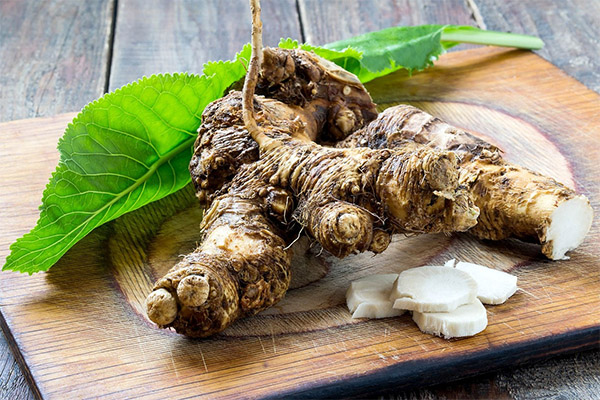
The plant is rich in vitamins (retinol, nicotinic acid, C and E, as well as a number of B vitamins), micro- and macronutrients (potassium, iron, sulfur, zinc, etc.).
Energy value: about 60 kcal per 100 grams, which makes horseradish a dietary product.
Useful properties of horseradish
If we talk about useful properties, in the first place we should note the ability to stimulate the body's immunity to various types of infections.
In fact, the plant has significant medicinal properties, which are recognized by official medicine. From it you can prepare infusions, decoctions and other remedies that will help with bronchial pathologies, cure cystitis, will be useful for asthma, hepatitis, infectious diseases, avitaminosis, etc.
For women
Every woman wants to preserve her beauty as long as possible, and horseradish can provide such an opportunity, since it contains vitamin E. It is also called the "vitamin of youth". Its value is so great that it is even produced as an active dietary supplement, it is included in most ointments and creams, and is a mandatory component of most vitamin complexes.
The fact is that retinol promotes active regeneration of dermal cells, their more rapid renewal. It makes the skin supple and beautiful. It also affects hair follicles, making them strong and thick.
Horseradish is also used to eliminate pain and discomfort during PMS. This is possible thanks to the same vitamin E.
Speaking about preserving beauty, we can not fail to mention vitamin A, which is a powerful antioxidant that blocks the effects of free radicals on body cells. This phenomenon is expressed in the prevention of cell damage and premature aging.
For women, an important factor is also the removal of toxins and impurities, it is necessary not only for health in general, but also for the correction of the figure.
For men
In today's world, ecology, stress, improper diet lead to a decrease in potency in men. If it used to manifest itself with age, today it has become the scourge of the young as well. Of course, there are many expensive medical remedies and other ways. But one of the easiest and most accessible methods to increase potency is horseradish. Regularly eating it as a supplement, you can significantly improve "male power".
In addition, horseradish is a powerful natural aphrodisiac - a means that increases libido not only in men, but also in women.
Not only can it increase potency or improve libido, but it is also used to treat urological diseases. It is a mild and safe diuretic that, among other things, strengthens the urogenital system and inhibits germs and viruses that lead to its diseases.
Another wonderful property that will be useful to men is the improvement of blood flow to the follicles. Studies have shown that horseradish masks and remedies are able to "awaken" the hair follicles and give them all the necessary vitamins and minerals. That is why it is used to treat baldness and profuse hair loss.
In addition, horseradish contains a large amount of potassium, which together with magnesium improves the cardiovascular system and prevents the occurrence of diseases associated with it, as well as reducing the risk of heart attack and stroke.
During Pregnancy
During pregnancy, women should be especially careful to monitor their diet, because some products can both benefit and harm the future mother and the baby itself.
It is important to understand that during pregnancy the immunity of the mother is weakened, and horseradish contains erucic acid. Even in healthy people it can cause problems with the gastrointestinal tract and give additional strain to the liver, which is extremely harmful in this position.
An important feature of horseradish is its ability to increase blood pressure, which is also not very good during pregnancy.
But to the useful properties can be attributed the ability of the plant to fight viruses that cause flu and other respiratory diseases. In this case, horseradish can help as quickly and safely as possible. It contains essential oils, which together with vitamin A have a greater effect on the body than lemon or other citrus fruits. It is best consumed for this purpose together with honey.
Nevertheless, pregnancy is not the best time to experiment with foods, it is better to postpone them for the postpartum period.
When breastfeeding
For most expectant mothers, the question of what to eat while breastfeeding often arises. This sometimes becomes a real dilemma. To answer this question correctly, you need to understand what happens to the baby himself in the first months of his life. A newborn baby's gastrointestinal tract is completely sterile. Various bacteria begin to "inhabit" it, which help digestion. But along with them comes a pathogenic environment, so there are colic, eating disorders, allergies, etc. That's why you need to choose your foods carefully during this period.

As for horseradish, it is an excellent anti-inflammatory remedy for colds, but you can use it while breastfeeding only after consulting your doctor. In general, in the first half of the year it is better to give up such products as horseradish, onions and radishes, since they have the property of strongly irritating mucous membranes.
Horseradish can be introduced into the diet gradually after 6 months, and you should closely monitor the baby's condition. If an allergic reaction - redness of the skin, the appearance of spots or itching - from the use of the plant should be abandoned immediately. You should also carefully monitor his stools.
For children
As mentioned earlier, horseradish strongly irritates the mucosa of the stomach, which can lead to GI disorders, as well as improper digestion of food. It is believed that you can introduce horseradish into a child's diet from the age of 4 years, but some pediatricians say the age of 7 years. In any case, you need to do this extremely carefully and monitor the condition of the body.
When not to give children horseradish as food:
- In allergies;
- disorders of internal organs: kidneys, adrenal glands and liver;
- Individual intolerance.
It is best to include horseradish in salads, dressing it with olive oil or sour cream.
The benefits of horseradish for children:
- The plant is used to make a remedy for respiratory inhalation for respiratory diseases and coughs.
- Leaves with honey - an excellent cough medicine and for relief of bronchitis.
- With a long dry cough, difficult to treat, use a remedy based on the juice of lemon and horseradish.
- Horseradish compresses can be used as mustard pads.
When losing weight
There is no woman who does not want to have a slender figure. Recently, the ecology, improper diet, sedentary lifestyle lead to the accumulation of fat in the body. In the pursuit of fashionable and expensive means, which sometimes raise doubts about the quality and efficacy, many miss the simple products that can actually help to lose excess weight.
One of these is horseradish. To make this clear, you need to figure out the "recipe" for a perfect figure. To do this, you need to engage in active sports and eat right. So how can horseradish help? The fact is that it has a "negative caloric value" in the first place. It is so insignificant that the body will need more energy to process it than it will provide.
The second important factor is its ability to improve gastrointestinal function by stimulating motility and peristalsis. It also contains a sufficient amount of insoluble dietary fiber, which removes toxins and impurities from the body, provoking the accumulation of fat.
In addition, horseradish stimulates the metabolism, speeds it up, thereby affecting the speed of metabolic processes, and this directly affects weight loss.
Another property that few people think about. Some time ago, it was thought that when dieting or restricting dieting, you can not include spices in the diet, because they increase appetite. But relatively recent studies have shown that this is far from the case. The unique taste, namely the bitterness of horseradish, dulls the taste buds. Thus, a person who consumes dishes with horseradish begins to eat much less, which is reflected in his weight.
The benefits and uses of horseradish leaves
The leaves of the plant are rather large, elliptical in shape and strong. Since horseradish belongs to the cabbage family, they remotely resemble a cabbage leaf. Horseradish leaves have been used in folk medicine since ancient times. And in England, the culture was originally grown exclusively for medicinal purposes.
The leaves contain many vitamins, phytoncides, dietary fiber and useful macro- and microelements. Unlike other plants, they are rich in proteins and carbohydrates.
The benefits of horseradish leaves:
- Draw out toxins and detoxes from the body by stimulating the gastrointestinal tract.
- They contain a lot of vitamin C (more than lemons, and they can rival blackcurrants).
- Are a natural antibiotic that inhibits pathogenic microbes and viruses.
- Helps to remove pigment spots from the skin.
The use of horseradish leaves:
- Making medicinal infusions and decoctions;
- canning of vegetables in cooking (they kill the pathogenic environment, which is the cause of rapid spoilage);
- antiseptic agent for dressings and compresses;
- prevention of the development of mold in vegetables, particularly tomatoes and cucumbers.
Horseradish in medicine
As mentioned above, horseradish has significant medicinal properties, and in some countries it was originally grown exclusively as a medicinal plant.
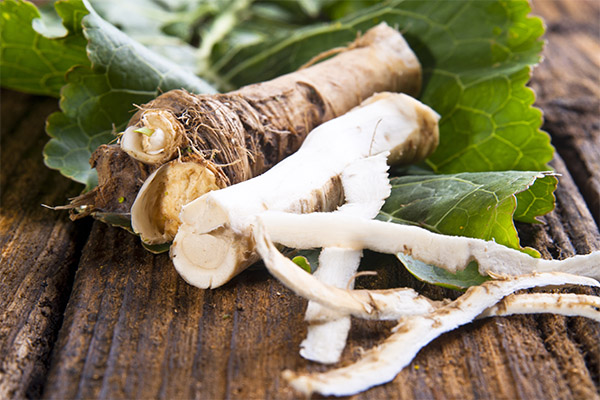
In Russia, in addition to being used for the preparation of various dishes, horseradish was also widely used in folk medicine. Almost from the very beginning of cultivation were known such medicinal characteristics of the plant:
- The juice obtained from the root has antibacterial properties.
- The root is used to treat and prevent influenza and other respiratory diseases.
- Infusions and decoctions of horseradish are recommended for mouthwashes for sore throats and tonsillitis.
- Horseradish decoction has been scientifically proven to be an excellent remedy for diarrhea. It is also used to treat ear infections.
In addition, it has been used to treat kidney diseases, urogenital diseases, malaria, gout, etc.
In Diabetes Mellitus.
Diabetes mellitus refers to an incurable disease. This pathology is characterized by the pancreas malfunctioning when it stops or does not produce enough insulin, which converts glucose into energy.
There are two types of diabetes: 1st and 2nd degree. While in the first case, the treatment is only insulin injections and a special diet, in the second, it is caused by unbalanced diet, stress, obesity, high physical activity and other factors.
As has already been said, not only treatment, but also nutrition is needed to successfully counteract the disease. So, foods that can lower blood sugar will help in the treatment, as well as reduce the amount of medications that have side effects. These include horseradish.
First of all, regular consumption of horseradish root and its leaves reduces the recruitment of excess weight, the main cause of type 2 diabetes. Also horseradish is an excellent remedy to help increase stress tolerance and normalize the gastrointestinal tract. It also promotes good blood circulation by reducing blood viscosity and improving the elasticity of capillaries and blood vessels.
It is important to know that you should not consume horseradish in any form during the acute phase of the disease.
Important: The glycemic index of horseradish is 35 units.
In pancreatitis
Pancreatitis, as well as diabetes mellitus, is an illness associated with pancreatic gland malfunction. In this pathology, the enzymes that it produces do not go into the intestine, but begin to be activated directly in it, which leads to its destruction. The cause of this disease in half of the cases is improper diet associated with alcohol abuse.
When treating pancreatitis it is important to observe, in addition to the course of treatment, also a strict diet. As for horseradish, it should not be eaten categorically not only during the acute phase of the disease, but also during the remission stage, and here is why:
- Horseradish has allergenic properties, and it is unacceptable during the inflammatory process and even dangerous.
- Such a bright and spicy taste of horseradish is due to the presence of essential oils, particularly mustard oil. In addition, it contains allyether and fatty acids that stimulate the release of enzymes that cause the destruction of the pancreas.
- Insoluble dietary fiber is invaluable for the gastrointestinal tract, but in pancreatitis it can have a detrimental effect: increased pain, diarrhea and gas, which is unacceptable in the disease.
Gastritis
Gastritis is a disease in which, as a result of exposure to a pathogenic environment, there is an inflammation of the mucous membrane of the stomach. Therefore, it is important to follow a strict diet for successful treatment.
With gastritis, it is strictly forbidden to eat horseradish, because the spice negatively affects the inflamed areas. The ban applies not only to the acute phase, but also to all stages of recovery. It does not matter at all what the acidity in the stomach - reduced or elevated. The use of horseradish with gastritis will aggravate the course of the disease and can lead to the formation of an ulcer.
In gout
Gout is a long-term disease expressed by inflammatory processes in the tissues of the joints, caused by a metabolic disorder. Often, along with medication treatment to combat the disease use unconventional means, in particular horseradish. It is noteworthy, but in European countries such as Belgium and France, the plant is officially recognized as a medicinal plant.
Compresses, baths, infusions and decoctions can help not only with gout, but also with other diseases. Horseradish, first of all, is useful because it contains many vitamins and useful substances that have a beneficial effect on the processes occurring.
For example, gout is characterized by an accumulation of urate or uric acid in the tissues, so with the pathology you should follow a certain diet, since these substances are products of protein breakdown. When treating it is necessary first of all to stop the development of the disease and relieve spasms and pain.
As for horseradish, infusions and decoctions are made directly from the root, and compresses are made from the fresh leaves. The plant helps to relieve pain, inflammation, and also helps in the removal of uric acid from the body. In addition, it improves blood circulation and normalizes the work of the gastrointestinal tract.
For the liver
Often horseradish is called the "Russian ginseng", but you should not abuse this plant. When the liver is impaired, it is strongly recommended not to eat horseradish, but it has a positive and even healing effect on it. There are even recipes that can slow down, as well as facilitate the condition of the patient with cirrhosis of the liver.
The fact is that horseradish has an excellent choleretic effect, it not only helps to restore the normal functioning of the organ, but also to prevent possible diseases in the future. For this purpose, you can use both the leaves, the plant, and the flowers, and the root. From them, various infusions, decoctions and other remedies are prepared.
In hemorrhoids
The cause of hemorrhoids, as in the case of pancreatitis, is primarily considered to be abuse of alcohol and improper diet. Horseradish in this case will be very useful both as a condiment for food, and in the form of infusions and decoctions. The reason lies in its useful properties, as it:
- Improves blood circulation in the body, including the lower regions.
- Normalizes the work of the gastrointestinal tract due to the presence of essential oils and coarse insoluble dietary fiber.
- Normalizes stools.
Based on the above, we can safely say that horseradish is able to eliminate the cause of the disease and create conditions for successful treatment.
Folk medicine recipes based on horseradish
As mentioned earlier, horseradish for health promotion can be taken not only in the form of a food supplement, but also to prepare from it various remedies.
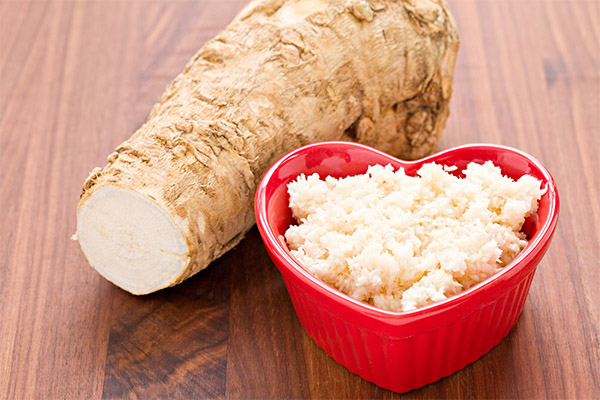
Treatment for diabetes
The ability of horseradish to reduce blood glucose levels became known relatively recently - at the end of the last century. It works especially well in combination with dairy products.
What will be needed:
- Sour milk - 1 l.
- Horseradish - 100 g.
How to cook:
- Rinse and peel horseradish thoroughly, then grind it, the best way to do this is with a grater.
- Add sour milk to the crushed horseradish.
The remedy should be taken before a meal, 1 tbsp. spoon 20 minutes, three times a day.
Recipe 2
There is also a recipe for the treatment of diabetes on beer and garlic. It will be to the taste of the stronger half of mankind.
What will be needed:
- Horseradish - the root should be about 20 cm long and about 1.5 cm thick.
- Garlic - a few cloves.
- Beer.
How to prepare:
- Wash the root, but do not peel it. Then grate it and pour it into a bottle.
- Peel the garlic and add it to the horseradish.
- Pour in fresh beer.
The resulting mixture should be kept in a dark place for about 10 days.
How to take:
- First you need to use 1 tsp. spoon three times a day before meals, for 2-3 days.
- After that, take 1 tbsp. spoon.
Take the medication for 1 month.
For the treatment of diseases of the joints.
For diseases and pain in the joints, various rubs of the leaves are used as a compress. However, there are also remedies that are recommended to take when such problems occur and inside.
To prepare it, you will need:
- Horseradish, celery and garlic - 100 g each.
- 1 large lemon.
How to prepare:
- Horseradish and celery are washed, peeled and chopped on a grater.
- Peel garlic and chop it as well.
- Then mix it up well.
- Add the juice of lemon.
Keep this mixture should be stored in the refrigerator. Use 1 tsp. spoon before a meal every day, once in the morning. It is especially helpful for rheumatism and back pain.
Osteochondrosis
A fairly common way to treat joint disease are various compresses and rubs based on horseradish. To prepare a rubbing, you need to take in equal proportions the juice obtained from horseradish and vodka and mix. This remedy relieves acute pain in the joints and muscles. After the procedure, it is necessary to keep the sore place warm, wrapping it with a woolen scarf.
The leaves of the plant are also used to treat osteochondrosis. To do this, you need to put them for a moment in boiling water, let them cool down and apply them to the focus of pain. A plastic bag should be placed on top and wrapped with a warm scarf.
You can also prepare a decoction, which is used for therapeutic baths. To do this, you need to grind half a kilogram of fresh horseradish leaves, then pour 750 ml of steep boiling water and leave to infuse for a day.
Then strain the infusion and add 1 cup to the bath, the water temperature should be about 40 C. It should be taken for half an hour. The entire course is at least 7 procedures.
Treatment of colds with horseradish
In folk medicine, the plant has long been used to treat respiratory diseases and colds. The anti-inflammatory and antibacterial properties of the plant provides a large content of essential oils in the leaves. For example, to treat nasal congestion, you need to put in your mouth just a quarter of 1 tsp. frozen horseradish. In just a few minutes, it will liquefy the mucus, which will speed up its exit, thus providing a quick recovery.
A tea made from ginger and horseradish can cure coughs and fevers. For preparation, two pieces of root of both plants are taken and boiled. It should be noted that the decoction turns out to be very spicy, giving it to children is categorically impossible.
Inhalation for coughs
Everyone probably knows that potato decoction is a great cure for a cough, but horseradish can be used to be more effective.
How to prepare:
- Prepare a decoction of potatoes. Do not drain the water.
- Then put in the broth some finely grated horseradish and 1-2 tablets of Validol.
It is necessary to bend your head over the container and breathe the steam for at least 10 minutes. For better results, the procedure can be carried out twice: in the morning and in the evening.
Horseradish in cosmetology
It is used not only to treat diseases, but also for cosmetic purposes, in particular for making masks for hair and face.
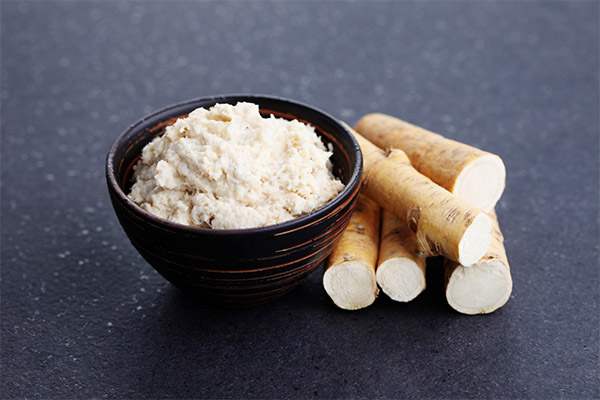
For the face
Horseradish, as a component of facial masks, restores the water balance in the dermis, makes the skin firm, beautiful and elastic. It is best used for aging skin and as a remedy for fatigue.
- Egg yolk based mask. For preparation, you need to take equal amounts of egg yolk, cream and grated horseradish. Mix all the ingredients (you can use a blender), then the product is ready for application. Such a mask should be left to act on the face for at least 15 minutes, then rinse and apply moisturizing cream.
- Horseradish and sour milk. For preparation you will need homemade sour milk, as much grated horseradish, to the mixture you need to add starch so that it is not too liquid. The mask will refresh the skin, add rouge and make it firmer. It is not recommended to make such a mask often. Once or twice a week is enough.
- Another excellent anti-aging mask is a mask made from horseradish and the most common oatmeal flakes. It is suitable for all skin types. However, if the skin is very oily, it is necessary to add an egg white, otherwise - an egg yolk. Mix horseradish and cereal in equal proportions, add an egg yolk or egg white, apply to the face and allow to work for at least 15 minutes. Then rinse with cool water and apply a suitable cream.
For hair
The main benefit of horseradish for curls is the activation of the bulbs, which leads to the growth of strong and lush hair.
- The most popular mask for hair is considered a mixture of horseradish and egg yolk. To prepare it, you will also need an egg yolk. It is prepared as follows: first, whip the yolk, add to it 2 tablespoons of cream and the same amount of grated horseradish, mix everything thoroughly. Whisk yolk and cream and add 2 tablespoons of cream and the same amount of grated horseradish. Let it act for a few minutes and rinse with water.
- Activating hair growth is a mask based on decoction of chamomile and horseradish, it also helps to heal micro-injuries and reduces inflammation of the scalp. For preparation you will need equal proportions of decoction of chamomile and grated horseradish, which should be mixed and applied to the hair and scalp. Let it work for a few minutes and rinse.
- Mask with horseradish for oily hair. You need grated horseradish and red wine. Mix the components carefully in a ratio of 1 to 2 and leave to infuse for 24 hours. Then apply it on your hair, leave it for a few minutes and wash it off with a shampoo. Such a mask helps to normalize the sebum secretion and removes oily shine.
Hints and Contraindications
Horseradish has a number of useful properties and qualities, but sometimes its use can cause harm to the body. This can occur in the following cases:
- with increased acidity of the stomach (it increases the production of hydrochloric acid in the body);
- Pancreatitis, gastritis and gastrointestinal disorders;
- Allergy to horseradish and individual intolerance;
- inflammation of the genitourinary system;
- High blood pressure;
- Any thyroid disorders.
It is also not recommended to use it during pregnancy and breastfeeding.
How to choose and store horseradish
To maximize the shelf life of horseradish root, you should choose it correctly. Horseradish is harvested twice a year - in spring and fall. The most optimal age of the plant is 3 years, you also need to consider the variety. The most popular are Volkovsky and Atlant.

When choosing, you need to pay attention to the following points:
- The root should not be too dry or old (sprouts have begun to appear).
- The length of the root - at least 20 cm.
- On the cut, the color must necessarily be white or milky.
- There should be no spots or traces of rot on the surface.
- The root is relatively even, light brown or yellow in color.
- Do not purchase horseradish roots with green flecks, they will be very bitter.
- It is better not to purchase the root in powder form in large quantities, as it will lose flavor quite quickly.
How to store:
- It can be stored in a plastic bag, in the refrigerator. In unwashed and unpeeled form, it can retain its qualities for up to 9 months.
- Peeled horseradish can be stored in the refrigerator for no more than 3 months. It is better to use it in the first 4 weeks.
- If the root has darkened, it is better to throw it away.
- To extend the shelf life of grated horseradish, you can use white vinegar and salt. With these components in a closed container, it will retain its taste and useful properties for a month.
Can I freeze
Horseradish root is not recommended to freeze or dry, since it will lose some of its taste qualities. In frozen form, it is stored for no more than six months.
How to cook horseradish: recipes
Seasoning
Homemade horseradish with beets is not only a great seasoning for vegetable, fish and meat dishes, but also a great preventive measure.
What you will need:
- Beet juice - 2 tbsp.
- Horseradish root - 300 g.
- Table vinegar 9% - 100 g.
- Sugar and salt - 1 tbsp each.
How to prepare:
- Horseradish root should be thoroughly cleaned of earth and washed in running water.
- Then grind, to do this, either use a grater or pass through a meat grinder with a fine mesh.
- The resulting mass pour steep boiling water (150 ml) and leave to cool to room temperature.
- To get the juice yourself, boil the beets and squeeze the necessary amount. For this purpose, it is better to choose a salad beet.
- When the horseradish cools, add the beet juice, sugar, salt and vinegar to it.
- Thoroughly mix everything.
The ready seasoning can be placed in a glass jar. Store it in the refrigerator, in such conditions it can last for about six months.
Serve best with meat dishes.
Recipe for "horseradish"
To prepare the appetizer you will need:
- Horseradish root and tomatoes - 1 kg each.
- Garlic - 3-4 cloves.
- Sugar - 2 tablespoons.
- Salt - 1 tbsp.
How to cook:
- Blanch the tomatoes and cut them into 4 pieces.
- Peel the horseradish and cut into small pieces.
- Peel the garlic and grate it on a fine grater.
- Then pass tomatoes and horseradish through a mincer.
- In the resulting mixture, add sugar, salt and garlic.
- Spread into jars and put in the refrigerator.
Such a snack can be stored for up to six months.
How much horseradish can be eaten per day
As an independent vegetable, horseradish is not recommended for use, since it is quite strongly irritating to the mucosa of the stomach, so it is better to eat it as a condiment to the food. In addition, excessive use increases the acidity of the stomach, which can not go without consequences for the gastrointestinal tract.
Interesting facts about horseradish
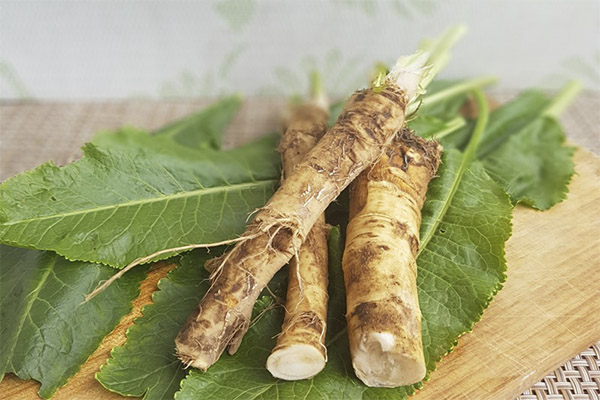
- Horseradish is often called the "Russian ginseng" because of the medicinal properties of the plant.
- It is still not exactly established where this plant comes from. For example, records have been found stating that horseradish was used even in ancient Egypt.
- In the United States, horseradish is a strategic product not only for medicine, but also for national defense.
- Recent studies by Japanese scientists have established the fact that horseradish actively fights the bacteria that causes tooth decay, and they plan to use it to create toothpaste.
- Horseradish has 5 times more vitamin C than any citrus fruit.
- Among other medicinal plants, it ranks first in importance.
- In ancient Rome, horseradish was used to treat sciatica.
- Some doctors say that if you breathe for a few minutes every day over grated fresh horseradish root, you can prevent the appearance of cancer.
- Horseradish is most widespread in cookery, used to make many sauces and seasonings for meat dishes.
- In Russia, a tincture of vodka and horseradish could be drunk at any postal station, it was believed to relieve any fatigue.
«Important: All the information on the site is provided solely for informational purposes. Consult with a specialist before applying any recommendations. specialist before applying any recommendations. Neither the editors nor the authors shall be liable for any possible harm caused by materials."


